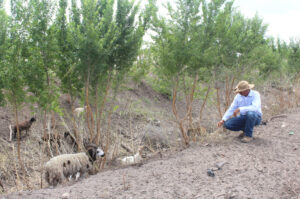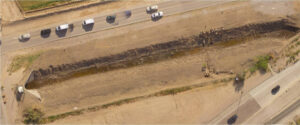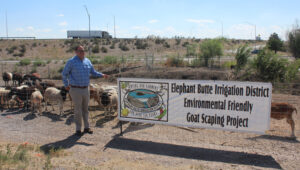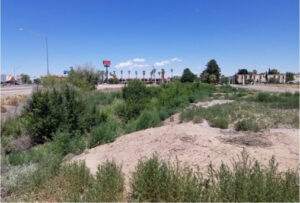The term goatscaping often elicits a quizzical look and a half smile, followed by the question, “What?” While the word isn’t in the dictionary and has nothing to do with scapegoats, it’s well known among land managers. Goatscaping is the centuries-old technique of using goats to maintain property.
The term goatscaping often elicits a quizzical look and a half smile, followed by the question, “What?” While the word isn’t in the dictionary and has nothing to do with scapegoats, it’s well known among land managers. Goatscaping is the centuries-old technique of using goats to maintain property.

The four-legged critters are hardy, notorious for eating everything, and can be easy to work with as long as you remember their streak of curiosity. They’re experiencing a revival of sorts, showing up as exercise buddies, pets, and urban farm stars. Worldwide, they work in a wide variety of settings, controlling and maintaining vegetation in parks, forests, and industrial locations. As they chew their way through overgrown, hard-to-access areas, they provide multiple benefits.
Goats’ strengths lie in their ability to completely digest weeds, brush, trees and their seeds. They eat younger trees, grinding up everything above ground and then digging up the roots. They eat woody plants and weeds that cattle and sheep eschew and can even eat some poisonous plants. Their grinding consumption and unique digestive system destroy the germination ability of nuisance trees like Chinese elm. Anything bigger than small grass seed has a tough time traversing their systems, ensuring that the animals’ manure helps to both reseed and fertilize beneficial plants in the enriched ground. This is a great advantage over mechanical weed removal devices like mowers and weed eaters that merely knock down and reseed problem vegetation.

Goatscaping overgrown areas can also provide vital protection against fire. California has used goats across the state to aid in brush control. Other states are taking notice of this alternative method for controlling problematic vegetation in a wide variety of areas.
New Mexican farmers recall that, historically, goat and sheep herds worked not only in the annual cleanings of acequias (community ditches) but also took part in canal and drain maintenance throughout the growing season. Elephant Butte Irrigation District (EBID), which is over 100 years old, is quite familiar with the constant task of staying on top of weed and brush control. Zack Libbin, EBID’s district engineer, explains, “Maintaining our 600 miles of canals, laterals, and drains is an ongoing issue. It’s very challenging. We’re trying to find more environmentally friendly, green ways to accomplish this. Going back to the old method will hopefully be a good solution.”
EBID began a two-part pilot project during summer and fall 2019 in two areas with vegetation problems. EBID Manager Gary Esslinger’s theory is that utilizing these voracious temporary employees to maintain district sites will reduce equipment and employee costs while improving infrastructure efficiency. “Their hooves working the ground can also help improve soil health and reduce erosion, creating a sustainable EBID’s first goatscaping site was the Park Drain near New Mexico State University (NMSU) in Las Cruces. In July 2019, the district contracted with a local goat herder, Jake Perrault of Green Machine Goatscaping, to provide about 70 goats to remove and consume unsightly vegetation within a 1-acre section of the drain.
Mr. Perrault is a native New Mexican with local family history dating to the 1800s. His affinity with animals, a vital trait for those working with livestock, started in childhood. He began working with goats to help his infant son, who suffered from milk allergies. “He was raised on goat milk. He would drink at least four goats in a week!” he laughs. He also discovered that his goat herd was an excellent way to reduce cover for predators intent on stealing his chickens.

Once turned out into the drain, the goats treated the steep banks and overgrown vegetation like their own personal playground, and in weeks had eaten it down to nothing. The herd was a strange sight juxtaposed with NMSU’s new Marriot Courtyard hotel, which stood nearby, but the goats grazed diligently, unfazed by the surrounding community, roads, and businesses.
“They are 24/7 eating machines,” Mr. Perrault says. He monitored them daily, supplying fresh water and supplemental food and adjusting animal numbers as needed. His carefully selected herd is composed primarily of goats, with a few mixed-breed sheep added in to provide a thorough vegetative cleaning. Sterling Grogan, a senior advisor to Carpe Diem West, says, “The sheep’s dietary preference is 75 percent grass, 25 percent other stuff. Goats’ dietary preference is the opposite: 25 percent grass and 75 percent forbs and herbaceous.” The result is something like turning teenage boys loose on an all-you-can-eat smorgasbord.
Mr. Grogan’s extensive experience in the land-management field includes using goats to control salt cedar and consultation on alternative methods of land management and rehabilitation. He acknowledges that “it’s not absolutely clear that goats are cheaper than chemicals. It might cost a little more, especially initially when you’re learning how to work the business properly.” Where goats have the potential to really shine as a control method is in the area of longer-term reduction in regrowth and sustainable site improvement. Using goat herders from within an irrigation district’s own state, he points out, can have a positive economic effect on the area along with the environmental benefits it brings.
EBID board member Joe Paul Lack was another goat milk aficionado as an infant and credits it for saving his life. He operates a long-running farm in the Rincon Valley near Hatch, New Mexico, right in the heart of chile country. Johnson grass was a big problem on the farm, and the previous owners management environment,” adds Mr. Libbin.
regularly used sheep to clean their ditches. He says, “You could hoe it today and it’d come back tomorrow. Those old sheep would eat it down really nice and close and that water would flow through those dirt ditches just beautifully.” Another advantage to using living mowing machines was that they served as a type of economic insurance: “One year, they had hail and no crop, so they sold the sheep to make their payment.”
Stage 2 of EBID’s pilot project involves North Doña Ana Dam, just north of Las Cruces, one of the 25 flood control dams the district is responsible for maintaining. Many of these structures were built in the late 1950s and early 1960s and have surpassed their 50-year design life. However, they are still relied on to protect not only agricultural land but also an increasing number of residential areas. Staying on top of their maintenance is crucial to public safety.
Stage 2 began in October 2019 and had similar requirements in terms of fencing, supervision, and herd density. The site is divided into two separate test areas, the first a 4-acre section requiring intensive grazing for soil disturbance, grass seed distribution, and woody vegetation removal. The goats’ hoof action on the dam’s top and face will aid in repairing the large number of erosion rills. The second area is slated strictly for woody vegetation removal. In this part of southern New Mexico, fighting the encroachment of extremely long-rooted brush like mesquite is an ongoing battle.
Woody vegetation can be particularly damaging to dams, canal banks, and drains. Mr. Libbin explains that roots can create natural flow paths through these structures, allowing water to enter and erode from within the embankment. To prevent surface erosion down the dam face, the district broadcast native grass seed at the time of goatscaping and included it in the goats’ feed. Carefully regulated supplemental feeding both encourages the animals to consume the woody vegetation and produces adequate organic matter to fertilize the broadcasted seed. Reducing onsite brush and trees also gives natural predators like hawks and coyotes easier access to burrowing rodents, which can damage the structures’ integrity. The district hopes that this maintenance process will help keep the aging dam functional.

Good communication throughout the project is vital in evaluating how long to keep the animals in a specific location and when to move them. It’s important to clearly delineate where the animals will be allowed on the property and to ensure that the goat herder is aware of the structure’s function as well as of any potential problems. Managers and herders should expect to work together to monitor the
project and ensure that it is proceeding as planned. Grogan stresses the importance of requiring goat herders to have “solid, 24/7 security for both the goats and the surrounding area” as a safeguard.
In his work for EBID, Mr. Perrault was responsible for all onsite fencing and goat supervision. In the United States, herds are typically supervised by a combination of human and animal guards, the latter including dogs, llamas, and donkeys. It’s important to be aware of all applicable regulations regarding animals in designated project areas. Mr. Perrault trains and selects his herd to respect the fence and to have easygoing personalities.
With goatscaping, as with many things in life, timing is everything. Turning the goats out to munch through an overgrown area is best done when the plants are tender and weak, prior to blooming and setting seed. However, goats can be used successfully on a maturely vegetated area for the initial cleanup of undergrowth. The key is to follow that initial cleanup with timely targeted repeat sessions.
Grogan’s observations of goatscaping sites in New Mexico and southern Colorado lead him to recommend, “Bring them back to your site a couple of times during each growing season for three consecutive growing seasons. At the end of the third season, the action of their hooves and their grazing will have stressed all the vegetation on a particular site. They eat everything!” This gives beneficial native grasses a chance to compete for scarce water resources and adds nutrients to the soil.
Goatscaping can be an effective tool for irrigation districts across the country. It can reduce the use of weed control chemicals, improve soil condition, and improve the maintenance of irrigation systems, thus facilitating more efficient water delivery and drainage. It may also enable irrigation districts to handle simultaneous operation and maintenance tasks when they would not otherwise have enough employees. The EBID team will continue to analyze the rehabilitation results of the Green Machine goat crew. This low-tech approach may prove to be a viable long-term method of keeping its system free of unwanted vegetation in an environmentally sustainable manner.
GOAT FACTS
Lifespan: 15–18 years
Gestation period: 150 days
Produce 2 kids on average
Able to digest and detoxify noxious plants
Resistant to bloating
Ruminant digestion
Goat milk is easy to digest
Herded for thousands of years
Karen Ray is a media consultant for EBID. She can be contacted at ray.karen7@gmail.com. For more information about EBID, visit www.ebid-nm.org.
